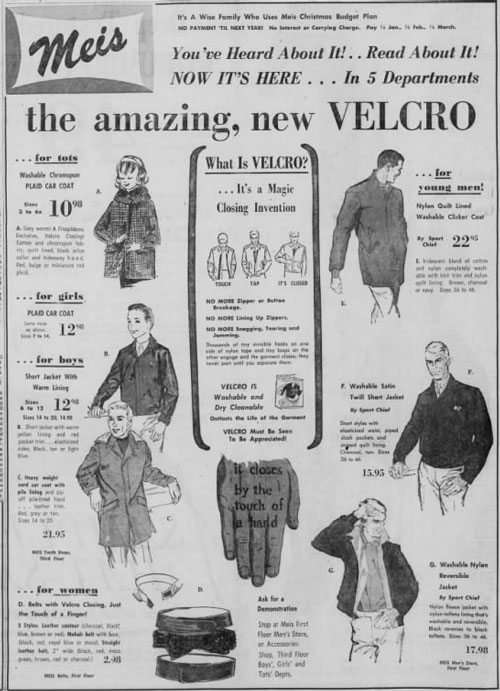Hooked On Velcro
How Velcro became one of the most important inventions of the 20th century, despite simultaneously gaining an unfashionable reputation.
Sponsored By … You?
If you find weird or unusual topics like this super-fascinating, the best way to tell us is to give us a nod on Ko-Fi. It helps ensure that we can keep this machine moving, support outside writers, and bring on the tools to support our writing. (Also it’s heartening when someone chips in.)

A burr just like this one inspired the creation of Velcro. (Selena N.B.H./Flickr)
The guy who invented Velcro was inspired by a prickly shrub, because of course he was
The thing with nature is that, often, it has solved a problem and has lots of examples of it in the wild long before the first human takes any steps to successfully design something that replicates it.
Certainly, for example, it was obvious that wings would eventually be replicated in man-made form, leading to aircraft. Birds are everywhere. The idea was apparent with no additional explanation. The issue, really, was technology.
But what about burrs? These tiny thorned stems, common to various plants, have this ability to stick to whatever soft, cushy thing passes by—turning anything that passes by into the perfect vessel for distributing seeds, and deterring animals from getting too close, among other things.
But while plenty of mammals have been annoyed by them throughout history, only one was observant enough to figure out that there might actually be a use case to these burrs that makes them awesome.

Where most people saw annoyance, George de Mestral saw inspiration. (Bru-nO/Pixabay)
And that mammal’s name was George de Mestral. A Swiss engineer who had, strangely enough, invented a model plane as a child, was inspired after a 1941 walk in the Alps with his dog in which he encountered a bunch of these burrs.
Most people would rub them off and forget about them, but de Mestral decided it’d be a great idea to analyze them under a microscope—and what he found inspired him to create.
Yes, someone else thought to put a burr under a microscope, thankfully.
The burr uses lots of tiny hooks to connect to the fur and clothing of many a passerby, effectively latching onto loops of soft hair or fur.
It’s worth noting de Mestral benefited from some other relatively recent inventions in attempting to recreate a synthetic variation on a natural phenomenon—specifically, nylon, a man-made take on silk that had been invented by Wallace Carothers and his team at DuPont just a few years prior to de Mestral’s fateful walk.
Perhaps the most challenging part of producing the material might have been creating the hooks, which involved heating the nylon using an infrared light, allowing the stiff side of the material to take and keep its shape. Per one of the many Velcro-related patents filed by de Mestral:
It is thus possible to use a pair of such pieces of fabric advantage as a substitute for the usual fastening means, such as slide-operated fasteners, ordinary buttons, press buttons or the like attaching means. As a matter of fact, it is sufficient to sew a piece of fabric of the type described along the edges of the parts of garments, curtains and the like, which are to be held together. A mere press sure exerted on the two garment elements against each other will provide for their fastening. A somewhat considerable tractional stress exerted on the two garment elements thus associated, allows separating them when required.
So really, de Mestral had to invent two items, one that required the other. The development process was lengthy—despite first coming upon the idea in 1941, he didn’t start developing until 1948, and finding the right materials took some time, with the discovery of nylon for the hook material proving the big challenge.
But eventually, he found it, reportedly by accident. And the result is one of the most quietly fundamental materials of the 20th century.
35
The weight, in tons, that a piece of Metaklett, essentially a Velcro-Inspired fastener made of steel, can support per square meter. The material, introduced in 2009, is intended for industrial applications where fabric might be a bad choice due to high heat or sanitary concerns.

A 1958 ad for Velcro that ran in The Terre Haute Tribune.
Velcro came out of nowhere to blow the American public’s mind
The fascinating thing about Velcro is it came about during a time in American history where many new inventions were becoming mainstream or getting perfected—think plastic squeeze bottles, walkie-talkies, ready-to-heat frozen food, instant mashed potatoes, steak knives, and styrofoam expanded polystyrene—many of which were directly inspired by World War II.
Despite this, Velcro doesn’t appear to have been directly inspired by the World War taking place in Europe during the period in which it was discovered and later invented, though certainly nylon’s early success is forever tied to its wartime use.
Nonetheless, the success of Velcro washed over the American market seemingly overnight. People had never seen anything like it before—and as such, it’s not hard to find articles written about the material from 1958 or 1959 that speak about it as if it was the most amazing invention of all time.
For example, widely read columnist Sylvia Porter (previously featured on Tedium trying to sell the masses on cashless transactions) wrote about Velcro as something of a wonder material, sharing an anecdote about how a zippered dress had failed her and how a “zipperless zipper” might have saved the day.
“The new fastening device—which is on my desk as I type this and which I have been opening and closing, opening and closing for days—is in many ways potentially more revolutionary than was the zipper a quarter-century ago,” she wrote in her 1958 column.
The rollout of Velcro to the American market took some time, with de Mestral’s team licensing out the material to an American company, and Porter writing of how fashion designers were closely keeping an eye on Velcro’s growth in Europe, hoping to latch onto its potential as a fashion innovator.
Early articles, of course, were quick to note how noisy it was. In a 1959 New York Times piece titled “Nylon Tapes Herald Ease in Dressing,” Nan Robertson described Velcro as such: “The big noise this spring will be a sound like ripping cloth,” she wrote. “It will herald one of the most revolutionary closures in history.”
Robertson, like Porter, suggested that Velcro would soon replace zippers and safety pins in the fashion world.
But, instead, the technology quickly gained a highly functional reputation. You can see this in the medical world in particular, where it’s on everything from surgical gowns to blood pressure cuffs, as well as in the world of transportation. You likely see it on every flight you’ve been on in the last quarter-century, and it’s probably in your car, too.
And as Velcro the company would be quick to tell you, their material went to the moon and was a prominent feature of Neil Armstrong’s space suit.
It’s strange how quickly Velcro went from being the greatest thing since sliced bread to part of the fabric of everyday life, but it happened—and quickly.
1984
The year David Letterman appeared on Late Night wearing a suit made of Velcro. The clip, one of Letterman’s most iconic and memorable sketches, features him and Velcro USA executive doing various things with the suit, including playing catch with a Velcro-covered basketball and jumping on a trampoline, hitting a Velcro-covered wall. The end of the sketch shows Letterman’s staff having to pull him off the wall as a group.

Velcro shoes, as intended for young children. As it turns out, adults are not so hot on this look. (Riala/Pixabay)
Velcro has an uncool fashion reputation, but we may be turning a hook-and-loop corner
A strange thing happened to Velcro on its way to changing the fashion world, however—it gained a reputation as being supremely uncool or best suited to niche audiences.
Sylvia Porter’s idea of a dress made with Velcro straps instead of zippers, which sounds reasonable from a distance, gave way to Velcro having a reputation as being a clothing option best suited for either children or the elderly, with not much room for in-between. Those little zippers didn’t actually go away for some reason, despite Velcro arguably being a better option. (Was it the fact that Velcro is noisy?)
Even in cases where Velcro might show up on clothing items worn by the average adult, they tend to be in places with not the best reputations, like cargo shorts. (Which, by the way, I will defend to the death as a useful and functional item. I am willing to debate you on this while wearing cargo shorts, Business Insider.)
Probably the best example of this, however, is the Velcro tennis shoe, a device which has gained negative connotations over the years, even though it often improves accessibility (because not everyone can tie laces) and, if designed properly, can actually be fairly stylish.

The LeBron Soldier XI FlyEase basketball shoe, which doesn't have laces.
In recent years, Nike has helped solve the fashionability problems related to Velcro shoes with the launch of a line called FlyEase, a shoe that in some variants has outward laces, but is actually locked in via a combination of strap and zipper. Crucially, the shoe does not draw attention to the fact it’s a Velcro tennis shoe.
It came to being in 2015, after the company was inspired by the needs of a teenager with cerebral palsy who wrote a letter to the company asking for a shoe he could put on himself. (Worth noting, because it will stand out if you read the letter: Matthew Walzer, the teen who asked for the shoe in 2012, is a graduate of Majory Stoneman Douglas High School, which has been in the news for tragic reasons this year.)
In recent comments to DisabilityScoop, Nike Senior Director of Athlete Innovation Tobie Hatfield noted the shoe line has made them think differently about accessibility.
“One of the key learnings we’ve had in crafting accessible footwear is the importance of easy entry and exit of the shoe, not just simplifying its fastening system,” Hatfield stated. “Eliminating the intricate hand movement of lace tying is important, but if the athlete cannot get their foot into the shoe, lacing becomes a moot point.”
Another factor that might be helping is the fact that Velcro shoes, as a trend, seems to be on the upswing. Vogue recently noted, for example, that Golden Globe winner and Black-ish star Tracee Ellis Ross has fearlessly embraced the Velcro sneaker, and it’s not unheard-of to find classy versions of the easy-to-mock shoe variant.
The truth is, though, that Velcro is the great signifier that function doesn’t beat form when it comes to fashion.
“Similar to the sound heard when gently separating the joined strip of Velcro on the blood pressure cuff (or jogging shoes), fine crackles have been coined ‘Velcro’ rales.”
— A passage from a 2012 European Respiratory Journal article that makes the case that the detection of “Velcro crackles,” a sound that lungs can make that literally sounds like a piece of Velcro being slowly pulled apart, is the best way of detecting whether a person has idiopathic pulmonary fibrosis, a chronic lung disease. The issue is prominent enough that the pharmaceutical company Boehringer Ingelheim, no kidding, made an app that challenges people to test their ears to see if they can detect "Velcro crackles.” Yes, Velcro inspired a medical term.
Last year, Velcro the company did something very amusing, probably inspired by the fact that, well, Velcro is essentially a generic term at this point, and the patents are long expired: It created a music video.
Part trademark plea, part tongue-in-cheek acceptance of the brand’s unfortunate situation, the company’s singing “lawyers” politely asked the public not to use Velcro when referring to the generic material that cheap manufacturers frequently undercut Velcro on from a price perspective.
(I’m sure Velcro would love me to use the phrase “VELCRO® Brand fasteners” rather than referring to Velcro in noun form, but I have my limits as a writer.)
Understandably, given the internet’s already shaky appreciation of trademark law and despite the funny way of asking, the company received a mixed reaction for this plea, and this week, the company released a follow-up video in which it gathered up the mean comments it received.
It’s officially the funniest music video you’ll watch today, at least 60 percent better than any “This is America” parody video you come across.
But in a way, the branding campaign does raise some interesting points—in a world where we protect copyright for far longer than it deserves, patents are protected for far shorter periods, a situation that puts trademark owners in an awkward position when they find everyone in the world referring to everyone else’s products with their name. (It doesn’t help that “hook and loop” is an infinitely lamer term than “Velcro.”)
“It's not about doing it for us, it's about doing the right thing,” the company argues on its website. “Successful brands around the world need your support to help protect trademark guidelines. Pledge to end the era of broken trademark laws.”
Velcro, the company, didn’t have to have a sense of humor about it, but somehow they did.
Perhaps that’s part of the reason why, as a company, they stuck around.
:format(jpeg)/2018/06/tedium060418.gif)
/2018/06/tedium060418.gif)


/uploads/ernie_crop.jpg)